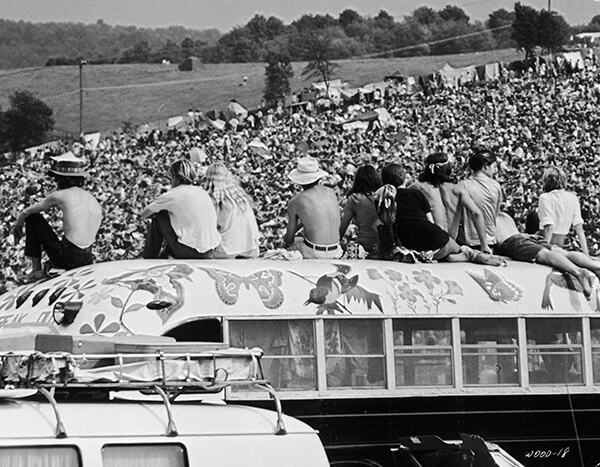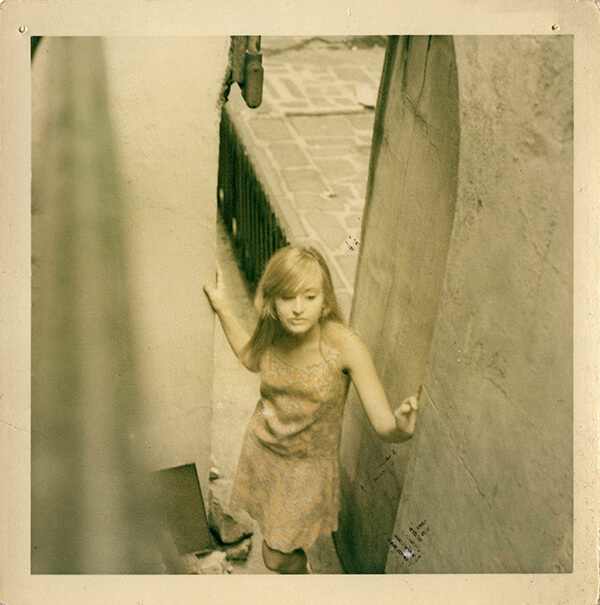The most iconic performance of the most iconic rock concert ever held would turn out to be the closing act: Jimi Hendrix, wearing a fringed white shirt; a thin red bandana circling his short Afro. Reaching the waking guests at 9:00 a.m. on August 18, 1969, he played a wildly electric, jarring version of the national anthem. This was certainly the most unexpected and dramatic version of “The Star Spangled Banner” ever performed, before—or after.
To some older people, hearing it on the radio, on TV, or in the eventual documentary of Woodstock, that jarringly counterintuitive version of the song seemed like a sacrilege. But to those peers gathered in the field or watching on their television screens, this completely original interpretation from the Air Force enlistee (Jimi had been part of the 101st Airborne) was something else. It was the youthful idealists’ plaintive, jolting wail of love needed for a country still in the midst of the Vietnam War with all the attendant deaths and protests; a country that had witnessed, a year and a half earlier, the assassinations of two spiritual leaders: Martin Luther King and Bobby Kennedy; a country that was experiencing so very much political division—division not unlike that we are experiencing now, even though it feels like there has never been as awful a now as now.
And this is where my personal Woodstock comes in. I didn’t go to the festival itself, but by a crazy, random fluke of friendship I had a brush with Jimi Hendrix that revealed much about manhood and appearances—and the difference between hype and reality—in that time, and ours.
Read More: Cass Elliot’s Daughter On the Crushing Fat-Shaming Her Mother Endured (The Untold Story)
The Woodstock Moment

Fans sitting on top of a painted bus at the Woodstock Music Festival, Bethel, New York, 15th-17th August 1969. (Photo by Archive Photos/Getty Images)
Fifty years ago today I was a UC Berkeley girl watching on TV what seemed like half of my generation travel the increasingly clogged roads, which eventually turned into standstill traffic, to Bethel, New York, where a sensational rock concert—“3 days of Peace and Music”—was beginning. I was used to protests and love-ins, given the Bay Area’s ownership of the same, but this seemed different—bigger—and it was televised live. Two young male promoters in their early 20s, backed by a 26-year-old financier, wanted to make it the biggest rock concert in history thus far—and so they did.
An expected 50,000 people would multiply into more than eight times that many. Boomer kids from all over the country got the message through their FM radio stations and “underground” newspapers, the social media of the day. These were long-locked boys in fringed vests and flowered shirts; the girls had sheet-straight hair, past their shoulders and center-parted, and wore hip-hugger jeans or long fair-maiden-from-another-century skirts. Many more just threw on tee shirts and jeans. They were there to celebrate love and themselves (generational narcissism was in full bloom) with joyous brio: to sit in the muddy field of a generous farmer, Max Yasgur, who consented at the last minute to have his acreage trampled upon.
The throngs of kids—unbothered by the rain and mud—hugged each other under blankets and shared food, LSD, joints, bandaids, and water while listening to the Grateful Dead, Joan Baez, the Who, the Band, Ravi Shankar, Sly and the Family Stone, Santana, and Creedence Clearwater Revival. (Any of these names ring a bell?) A couple of babies were born in the field; there were 400 bad acid trips, which were serviced by a makeshift medical crew; Swami Satchidananda wafted in to give the blessing to the crowd; and not a stitch of violence erupted. Street signs sprouted up—Groovy Path, Gentle Way, High Way—courtesy of a group led by an old beatnik who’d rechristened himself Wavy Gravy.
Beyond Parody
Groovy Way; Wavy Gravy! Oh, 1969 Woodstock—you only recently looked so wonderfully parody-worthy! But today, in our current America—with 31 people murdered and many more injured in two mass shootings in one weekend, allegedly by two very young White Nationalists who, in another era, sitting alienated in their parents’ basements, might have grabbed onto that very different rebel zeitgeist; with a 2020 election campaign that seems set to be based on the President’s racism; with immigrant children, separated from their mothers, crammed together atop their feces in border cages.
Today, the memory of that half-century-ago convocation of peace and love is making me kind of wistful. No wonder Marianne Williamson’s swaggeringly confident talk of love has been so arresting and has caught off-guard even those who roundly dismiss her presidential candidacy. Though community and activist spirit, among good people, to fight the cruelty in this country has never been stronger, how nice (if implausible, perhaps) it would be to have now a modern version of the love and community that was so vitally appealing during those three days in upstate New York 50 years ago.
The divide between young/hip and old/straight had been around since 1966’s Human Be-In in San Francisco’s Haight Ashbury, and it had been celebrated with every smoked joint and every dunking of a knotted cotton T-shirt into a tub of Rit dye. It had taken three years for the lifestyle’s tentacles to stretch across the country and, in 1969, a Haj to a Mecca had seemed in order. Woodstock would be pure democracy: wildly enthusiastic college kids, working- and middle-class hippies, and drug-brined riffraff. As Arnold Skolnick, the artist who designed the festival’s catbird-on-guitar logo put it, “Something was tapped—a nerve—in this country. And everybody just came.”

The author, Sheila Weller, circa 1969.
The Song, The Poetry
When Janis Joplin arrived by helicopter—as did many of the stars—she thought the scene was “Biblical” in scope, Peggy Caserta, her companion at the time, recalled in a NextTribe interview last year. Gazing in wonderment at the ocean of people before she took the stage to belt out her soulful “Piece of My Heart,” she caught the potential sociopolitical significance. “For every one of these people out there, there are at least ten who couldn’t make it,” she told Caserta. “We could throw an election—we could put in a new president!” (Alas, this would be wishful thinking on Janis’s part. Sitting President Richard Nixon would win re-election in 1972 against Democrat George McGovern by a record landslide.)
The site was so intensely crowded—with the 450,000 to 500,000 souls (the estimates varied)—that, though Joni Mitchell had flown in from L.A. to appear, her managers thought it was too dangerous for her to venture into the heady madness. So she watched the bacchanal on her hotel-room TV set. Like Janis, she would make a Biblical reference. She called it “a miracle, a modern loaves-and-fishes story.” She wrote a song about the weekend in counterintuitive minor mode. It had a primordial, Nordic winter-forest sound, with Biblical sentiments that started with the first line: “I came upon a child of God; he was walking along a road.”
She conflated the non-threatening helicopters soaring into the meadow with the military craft of the ongoing Vietnam War, expressing the buoyant, naïve hope that fueled the day by imagining those war aircraft idealistically “turning into butterflies across our nation.” But it was the song’s hook—“We are stardust; we are golden”—that made it so hauntingly elegiac and conveyed the impression of hundreds of thousands of people speaking as one. David Crosby—who did perform, with Stephen Stills and Joni’s then-boyfriend Graham Nash (as Crosby, Stills, and Nash, they made that song, in rock beat, their defining hit)—later said, “Joni contributed more towards people’s understanding of that day than anybody that was there.”
Joni absorbed the magic through the screen and made real poetry of it, and her song—simply called “Woodstock”—conveyed the mystical quality of the day in such an artful way that, years later, cultural critic Camille Paglia would opine that the lyrics to “Woodstock” constituted one of the 43 best poems produced in the English language.
Read More: Music for the Ages! Brandi Carlile, Judy Collins, Sheryl Crow, and Dolly Parton Team Up
Jimi and Me
A month and a half after the iconic concert was over, in October 1969, I was visiting the town of Woodstock (about 45 miles from the actual concert locale) with a college friend. She happened to be dating a musician who was Jimi Hendrix’s new mentor. “Hey, let’s go over to Jimi’s house,” he said. As casually as if we were visiting a random friend (or so I tried to pretend,and it all happened too fast to over-think, or even wash my hair), we went over to the house right outside Woodstock that the festival star was renting and using as a rehearsal space for his new band, Gypsy Sun and Rainbows. Jimi Hendrix, of course, was famous for burning his guitar onstage, for being super-macho. The distorted photo of him on his debut hit album Are You Experienced? made him look big.
What a surprise I was in for.
On that afternoon and the next day when we paid a second visit, Jimi was the total opposite of his image and reputation: a thoughtful, vulnerable, self-deprecating young man with a slight build, a fragile appearance, a worried air, and a fuss-budget’s demeanor: “I’m a clucking old grandmother,” he said at one point, as he walked around his house, emptying ashtrays. He had unexpectedly un-rock-n-roll taste in music: He proudly brandished albums of Schoenberg and Marlene Dietrich, but also proudly displayed a photograph of himself in the old R and B band he had spent time in before he turned psychedelic.
He coughed and apologized a lot. He seemed far too delicate and insecure for the icon status he had gained. And when, less than a year later, on September 18, 1970, he died, at the age of 27, choking on his vomit after an apparent drug overdose, I realized that the young man I had spent some hours with, in the company of friends had probably, that day, likely been on the verge of a nervous breakdown.
No More A Clown
He talked about how he wanted to change his image—the macho guitar-immolation had gained him notoriety, but he wasn’t that man, and I could tell that. When he said, “I don’t want to be a clown anymore,” I snuck into his bathroom and wrote that memorable phrase down. A week later, as a rookie, I wrote an article about him and sent it, cold, to Rolling Stone—and that phrase became its headline.
In several biographies of Jimi—I discovered only many years later—I was called a Rolling Stone correspondent. I laughed at that! While I would later write a bit for Rolling Stone, this story was the work of an earnest wannabe-hippie girl, not a staffer or a pro, taking advantage of a completely serendipitous meeting with a superstar: a moment in which he had talked, off the cuff, with a touching introspection.
Okay, you may be thinking, you’re romanticizing him so much; was there something more? Well, kind of. At the end of the second day there was a bit of what we used to call making out, and if this was anything but a gentle guy, I didn’t see it. Then I did something remarkably smart, using my natural insecurity as a self protective strategy: He asked me if I wanted to stay overnight, and I said I couldn’t, that I had commitments in the city. I knew that if I—a cute but unextraordinary girl—lingered with one of the hottest men in the world, the burden would be on me to beat the extremely high odds to not end up boring and overly available.
It was too big a burden for me, especially with unwashed hair. The Woodstock festival had been about idealizing reality. Saying no to Jimi Hendrix was a way to idealize the serendipitous time with him and keep it that way, rather than have to battle some memory of myself as an inept groupie every time I heard “Hey Joe.”
And idealize him I continued to do. There was also something that I would later define as almost feminine about Jimi: the airy way he talked; the tender, neat calligraphy in the notes I saw him taking in a jeweled Moroccan journal; the girlish spelling he’d devised for his name; the fact that, years earlier, he had been one of the first men to wear flowery poet’s shirts and jeweled vests; the curlers he used to set his hair, going for a Dylan look. Thinking back on it, as I did, about 12 years ago when an editor sent me a big coffee table book of Jimi’s delicate writings and drawings—including artistic little fold-out notes such as children make in art class—I realized that this supposedly ultra-macho man was actually a harbinger of androgyny.
That the Jimi Hendrix I experienced in person was so radically different from his reputation and mystique held a lesson for me then, and, as much of a stretch as it may seem to be, it feels like a lesson for now: a lesson that I wish could be relayed to the furious young men who are writing manifestos and walking into public places with firearms that should clearly be illegal, killing people they have never met. The message is this: We have to wait and believe our eyes and ears and see the humanity before us, not that myth, hype, stereotype, expectation, or dogma.
During the afternoon, my friends and I got into Jimi’s car, and even then it occurred to me what an unselfconsciously mixed group it was: Jimi, a black man from Seattle; my Chinese-American friend Linda; Jimi’s friend and mentor Juma, also black; a white male British avant garde pianist, and his beautiful black girlfriend who practiced Islam; and me: a blond Jewish onetime Beverly Hills High School cheerleader. On the narrow Woodstock road, we encountered, coming toward us, another car, full of the same diverse mélange of young people, and (yep, this was 1969) we all lifted up our hands and gave one another the V peace sign. Even then I said to myself: This is a quintessential moment; don’t forget it.
And I haven’t. So, amid the mayhem and cruel divisiveness of 2019, I raise my coffee cup: Here’s to the spirit of Woodstock, at least for a fleeting moment.
***
Sheila Weller is the author of seven books (three of them New York Times Bestsellers), the best of which is Girls Like Us: Carole King, Joni Mitchell, Carly Simon—and the Journey of a Generation, which Billboard magazine recently named #19 of the best music books of all time. She has been writer of major features for Vanity Fair, a recent longtime senior contributing editor at Glamour, a has written for the New York Times Opinion, Styles and Book Review and for just about every women’s magazine in existence. She has won 10 major magazine awards.




















0 Comments